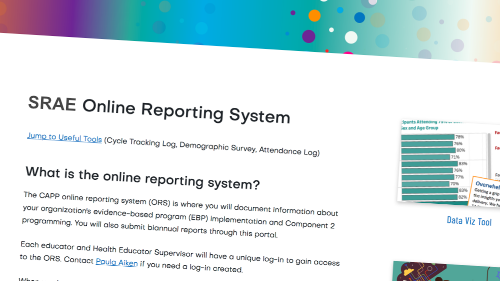SRAE Component 1: Evidence-Based Programs
Delivering evidence-based programs (EBPs) effectively is rarely simple. However, high quality implementation is within reach. ACT for Youth provides training, capacity building, and evaluation services for many NYSDOH-funded programs implementing EBPs. We are available to guide you through the process.
SRAE projects provide sexual risk avoidance education using one of the following EBPs:
Getting Started with Evidence-Based Programs
Fidelity and Adaptation
If you're new to implementing evidence-based programs (EBPs), you'll find we put a great deal of emphasis on fidelity: implementing the program as it was designed. That is because while all EBPs have been evaluated and found to be effective, we don't know specifically which content, teaching strategies, and implementation factors make the program effective. If we want to see positive outcomes, we can't improvise because we might be tampering with the "recipe" that makes the program work. That is why it is important to deliver the program as developed, staying true to its core components. Doing this successfully requires considerable planning and preparation.
Any planned adaptations to EBPs must be reviewed and approved by ACT for Youth. See the web page for your EBP to learn more about the approval process. All adaptations — planned and unplanned — are documented in the SRAE Online Reporting System.
What is an Adaptation?
Adaptations are any changes to the core components of an evidence-based program. While some adaptations may be helpful — such as using inclusive language, making activities more interactive, and updating statistics — others will compromise the integrity and effectiveness of the program.
| Core Component | Adaptation Examples |
|---|---|
| Content: What is being communicated? |
Adaptations might include changing the language and scenarios of role plays, updating health information, or using local statistics. |
| Pedagogy: How is the content being taught? |
Pedagogy refers to teaching strategies. Adaptations may involve structuring activities differently. Replacing a short lecture with a game that covers the same content, for example, is a change in teaching strategy. |
| Implementation: How is the program being delivered? |
The recommended group size may be from 6-12 participants. In certain settings, however, group size may vary from 15-25 participants. |
Organizational Readiness
Organizational readiness is vital for successful implementation. If upper-level administrators, coordinators, and frontline educators alike do not understand why the project was funded, the project's implementation goals, and the demands of implementation with fidelity and quality, they are unlikely to support successful implementation. These resources will help you reflect on your project's readiness.
Working with Community Partners
While some organizations may already have space on site for out-of-school programming with youth, others may need to create partnerships with community partners in order to use their space. Conducting an EBP at another organization can present challenges, but can also strengthen community connections and provide unique opportunities for collaboration.
Begin by being clear about your needs and taking stock of the current contacts and partnerships you have. For example, do you already have access to youth participants and only need the space to deliver the EBP? Do you have the space, but do not know how to recruit youth outside of a school setting? Or are you in need of both youth and space to engage them?
Engaging community partners in planning and implementation will not only improve programming, it can also help you create a network of support around the youth you are working with.
Trauma-Informed Approach
All SRAE projects should take a trauma-informed approach to program delivery, intentionally taking steps to understand, recognize, prepare for, and respond to the effects trauma may have on program participants.
Recruiting and Retaining Participants
Recruiting and retaining youth in prevention programs can be difficult. Although challenges may vary from community to community, there are a few consistent issues to consider:
- Have you involved young people in your program planning process?
- Is your recruitment and retention strategy intentional and well planned out?
- Does your recruitment and retention strategy include activities that are creative, youth-approved, and youth-affirming?
- Are your meetings in a physical location that's safe, comfortable, convenient, and familiar to your priority group?
- Is your staff reflective of the participants?
- Is your space inclusive and welcoming of diverse groups?
Another strategy is good, old-fashioned word-of-mouth! Encourage current or past program participants to be "ambassadors" for you.
And remember, young people in programs still spend a lot of time with their caregivers, so if you can get the adults in their lives interested in the programming you offer, there's a better chance the youth will participate.
The resources below will help you plan your participant recruitment and retention efforts.




